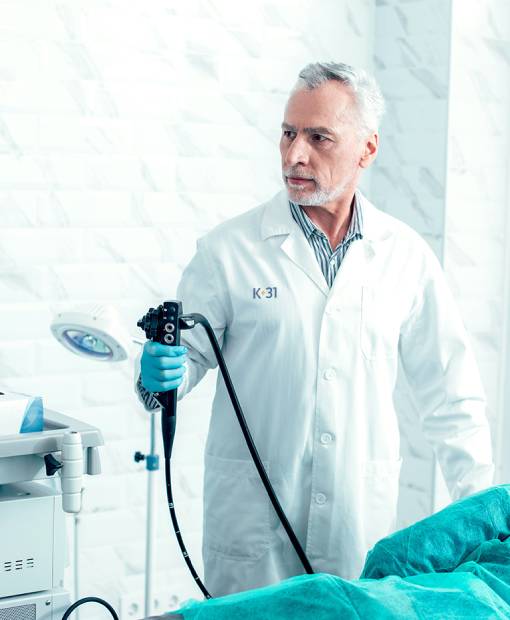Balloon-assisted (two-balloon) enteroscopy

specialists

equipment

treatment

Balloon-assisted enteroscopy is an examination of the small intestine using a special system consisting of an enteroscope, a tube-tube with an inflatable balloon and a console with the ability to display an image on the screen.
The enteroscope, as well as with conventional colonoscopy or EGDS, has a channel for the manipulator. This allows you to perform biopsies, remove small tumors, stop bleeding in the small intestine, which is a huge breakthrough in gastroenterology.
Visualization of the small intestine has always been a great challenge. For many years, the only widely used method was x-ray examination after administration of a contrast agent.
In 2001, when the method of video capsule enteroscopy appeared, the diagnosis of the small intestine moved to a new stage of development. With the help of a small swallowable capsule with a built-in video camera, you can see the condition of the inner wall of the intestine. However, video capsule enteroscopy has several significant drawbacks: there is no possibility of tumor biopsy, removal of neoplasms, bleeding control and other therapeutic measures. These shortcomings are devoid of balloon-assisted enteroscopy.
The tube-tube is a soft silicone "nozzle for an enteroscope" 140 cm long, at the distal end of which there is a balloon. The tube-tube is movable relative to the endoscope, providing patency through the small intestine.
Of course, the human intestine is more than 200 cm, so enteroscopy can be performed from two approaches: transoral (through the esophagus and stomach) and transrectal (through the rectum). The study is usually started by introducing an enteroscope through the mouth. If the alleged pathology can be found at the same time, the study ends. Otherwise, a label is placed in the intestine, and they proceed to examination through the rectum. The criterion for a complete examination of the intestine is to find the left mark during enteroscopy from another access.
Balloon-assisted enteroscopy is performed for diagnostic purposes in the presence of a clinical picture of diseases of the small intestine (frequent loose stools, weight loss, anemia of unknown origin).
For therapeutic purposes, balloon-assisted enteroscopy in K + 31 is performed to stop intestinal bleeding, to remove small benign tumors (papillomas), to eliminate local narrowing of the intestine, to evacuate foreign bodies.
Also, balloon-assisted enteroscopy can be performed to monitor and control the effectiveness of treatment.
Preparation for the study is the same as for other endoscopic examinations of the intestine (enemas, Fortrans), however, to decide on the individual characteristics of the preparation, it is necessary to consult a doctor in advance.
Balloon-assisted enteroscopy is performed with great caution or not performed at all in patients after extensive abdominal surgery, especially after peritonitis, which is accompanied by the formation of pronounced adhesions between the loops of the small intestine. The adhesive process grossly violates the normal anatomical mutual position of the intestine, which makes it inaccessible for balloon-assisted enteroscopy. This diagnostic procedure is contraindicated in patients with severe strictures and large tumors of the small intestine, detected by X-ray examination.
The endoscopist has the full right to refuse balloon-assisted enteroscopy if the patient has not followed the recommendations offered to him in preparing for the diagnosis.
There are two main types of balloon-assisted enteroscopy: single and double balloon enteroscopy. The advantages of the first over the second are purely technical: there is no need for an assistant, the device is easier to use, and the examination time is accelerated. There are no significant differences between these two methods in terms of diagnostic capabilities.
At K+31, balloon-assisted enteroscopy is performed by the best specialists, who were among the first to introduce this technique in Russia. We keep the health of patients in focus and, in addition to enteroscopy, we offer patients a comprehensive examination of the gastrointestinal tract. This allows you to identify pathological changes in the early stages, prescribe treatment and maintain health for you.
Price
Make an appointment at a convenient time on the nearest date
Our doctors

This award is given to clinics with the highest ratings according to user ratings, a large number of requests from this site, and in the absence of critical violations.

This award is given to clinics with the highest ratings according to user ratings. It means that the place is known, loved, and definitely worth visiting.

The ProDoctors portal collected 500 thousand reviews, compiled a rating of doctors based on them and awarded the best. We are proud that our doctors are among those awarded.


















